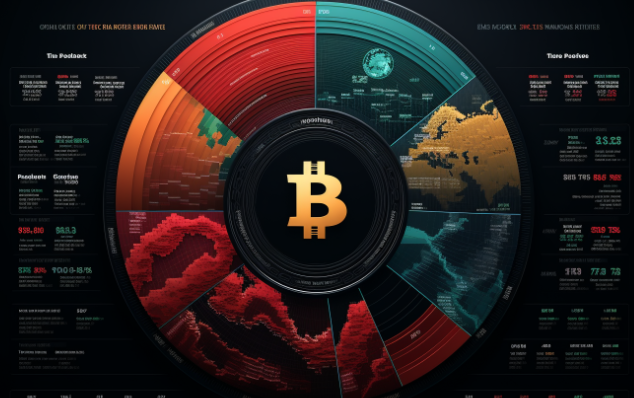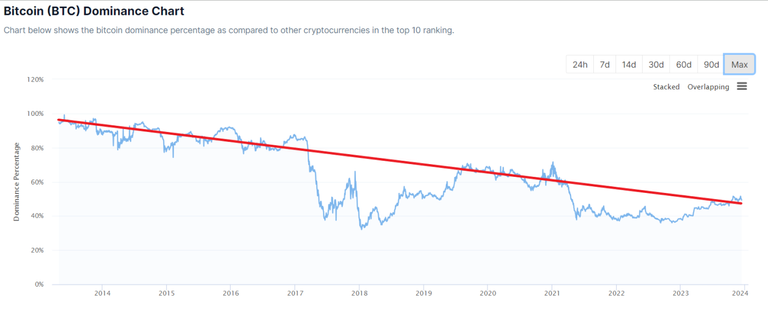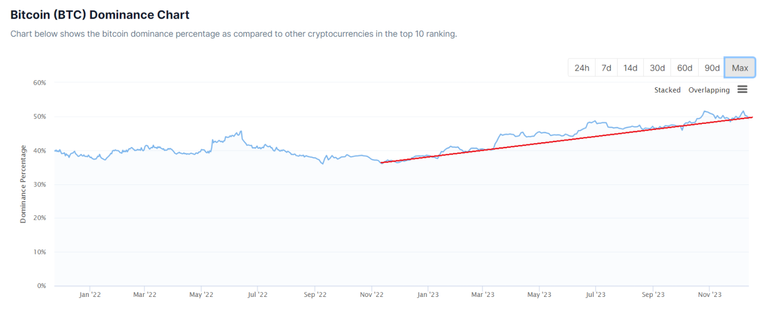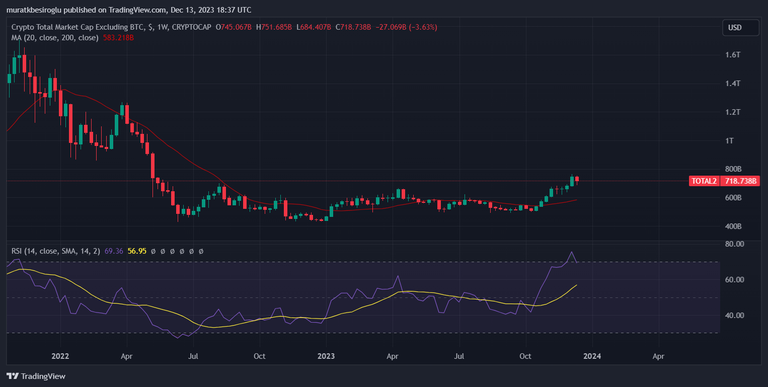
In the beginning, as we all know, there was only Bitcoin. Bitcoin dominance began to decline as altcoins emerged. This process proceeded slowly. Bitcoin dominance dropped from 100% to 95% at the end of three years. Bitcoin's share of the total crypto market value has steadily decreased, and the 2017 bull market became a milestone. In the following period, Bitcoin's dominance fell during bull markets and increased during bear markets. In the chart below, sourced from Coingecko, we see the development of Bitcoin dominance since 2013.

I added the red trend line to the chart. The trend line shows that Bitcoin's dominance is decreasing at an annual rate of 4.1%. This decrease is not regular. As mentioned above, Bitcoin's share of the total decreases during bull markets and increases during bear markets.
The decline in Bitcoin dominance is occurring relatively quickly in the last period of the bull market. We also call this period the altcoin season. We have witnessed a rapid increase in the price of some altcoins in the last few months. Has the altcoin season started?
Long-term trends need to be evaluated together with short-term price movements. A close look at the last few months of data can help us predict the market's direction.

The chart shows that Bitcoin's share of the total has been increasing since November 2022, and we cannot say that the increasing trend has ended yet. On the other hand, the situation is still possible for altcoins. Because Bitcoin's dominance returned from 51.5% twice, it may not rise again to this level, or if it tries once more and cannot break it, it may come down quickly.
To understand whether the altcoin season has started, we can look at the market value development of altcoins. The chart below shows the total market value of coins other than Bitcoin.

In mid-October, the total value of altcoins exceeded its 200-day average. The weekly RSI value also rose above 50 on that week. Thus, a rally occurred in which the value of altcoins increased by 40%.
Has the altcoin season started? The answer to this question may vary depending on what we understand from the altcoin season. For now, investors are choosing certain coins to ensure their rise. There is no general solid increase. For example, there was no significant movement in Hive. Hive price is fortunately above its 200-day average. The weekly RSI is also above 50. If the Hive price can break the 40-cent resistance, the price will quickly rise to the 50-cent region.
TL;DR
When we examine the last ten years of data, we see that Bitcoin's dominance is in a downward trend. Bitcoin's share in the crypto market is decreasing by an average of 4.1% annually. On the other hand, Bitcoin dominance is highly affected by bull and bear markets.
When we examine recent data, we see that Bitcoin's dominance has increased since November 2022. The share has returned from the 51.5% level twice, but the uptrend has yet to end. My expectation for Bitcoin dominance is that it will remain horizontal next year. There has been a climate where we can invest in the altcoins we like now. Still, the climate doesn't deserve to be called altcoin season because we have yet to see satisfactory price increases in altcoins.
Although Hive's price is upward, it has difficulty exceeding the 40-cent resistance. The price will quickly rise to 50 cents if this level is exceeded.
The prices of many altcoins are still highly affordable. Even though the altcoin season has not started, it is the right time to invest because prices are still attractive.
Thank you for reading.
Cover Image Source: Midjourney App




